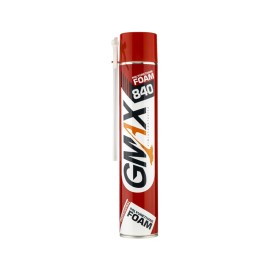

Gun foam polyurethane 840
GMAX Spray Polyurethane Foam (SPF) is a high-performance insulation material, widely recognized for its durability, efficiency, and ease of application.
Why Choose GMAX Polyurethane Foam?
✅ Proven Technology – Originally developed in the 1940s for military aircraft, SPF became a standard insulation material by the 1970s.
✅ Advanced Composition – Made from two key liquid components, polyol and isocyanate, which react upon mixing to expand into a rigid, durable foam.
✅ Superior Insulation & Longevity –
✔ Rapid solidification ensures long-lasting insulation that resists cracking and deformation.
✔ Provides excellent thermal and sound insulation for various applications.
✔ Excess foam can be easily trimmed for a precise, clean finish.
Ideal for Permanent Insulation Solutions
Whether for residential, commercial, industrial, or automotive applications, GMAX Polyurethane Foam delivers exceptional performance and energy efficiency, making it the go-to choice for professionals and homeowners alike.
technical specifications
|
Density |
23 g/ml |
|
Temperature resistance |
-40 c &90 c |
|
Free sticking time |
10 mins |
|
Tensile strength |
9 N/CM2 (DIN 53571) |
|
Shear strength |
5 N/CM2 (DIN 53427) |
|
Elongation at break |
20-25% |
|
Compressive strength |
4 N/CM2 (DIN 53427) |
|
Foam expansion |
100% to 200% |
|
Water suction |
MAX 1% |
|
Fire properties |
B 3 |
|
Heat conductivity |
0.021 w/MK (DIN 52612) |
|
Curing time |
20 C1 CM/hour (high humidity) 20 C0.5 CM/hour (low humidity) |
|
Gross weight |
850 gr |
product usage
GMAX Polyurethane Foam is a versatile and high-performance solution for a variety of insulation and sealing needs. Here are some key applications:
1. Sound Insulation 🎧
✔ Ideal for engines, vehicles, and partition walls to reduce noise and enhance soundproofing for a quieter environment.
2. Sealing 🔒
✔ Provides strong and durable sealing between wooden panels, ensuring protection and long-lasting performance.
3. Filling Gaps 🔧
✔ Perfect for filling seams, cavities, cracks, and fractures around water and electrical systems, preventing leaks and improving safety.
4. Thermal Insulation 🌡
✔ Effectively insulates sewer pipes, water pipes, and central heating systems, improving energy efficiency and reducing heat loss.
5. Door and Window Sealing 🚪
✔ Ensures airtight sealing between wooden doors, windows, and PVC, improving insulation and reducing energy loss.
6. Panel Insulation 🏠
✔ Suitable for insulating wall panels, prefabricated walls, and ceiling panels, offering superior thermal and soundproofing properties.
how to maintain
To ensure safe and effective use of GMAX Polyurethane Foam, please follow these important safety guidelines:
Protective Gear 🛡
✔ Always wear a mask, goggles, protective clothing, and safety gloves when handling the foam.
Avoid Inhalation 💨
✔ Do not inhale the vapors released by the foam during application. Always apply in a well-ventilated area.
Eye Contact 👁
✔ In case of contact with eyes, rinse immediately with plenty of water and seek medical attention without delay.
Storage Guidelines 📦
✔ Store the foam in a cool, dry place.
✔ Keep it away from direct sunlight.
✔ Ensure the storage temperature remains below 50°C to prevent hazards.
Caution After Use ⚠
✔ Do not pierce or burn the foam cans after use.
✔ Keep out of reach of children for safety.
By following these safety precautions, you can ensure the safe handling and effective use of GMAX Polyurethane Foam in your projects.
How to use
Step-by-Step Guide for Using GMAX Polyurethane Sealant Spray Foam
For optimal results when using GMAX Polyurethane Sealant Spray Foam, follow these easy steps:
1. Surface Preparation 🧼
✔ Clean the surface thoroughly, ensuring it’s free from grease, dust, and debris.
✔ Proper surface preparation ensures a stronger bond between the foam and the surface, improving the durability and effectiveness of the seal.
2. Shake the Spray Foam 🔄
✔ Shake the canister vigorously for 1 minute or at least 20 times before use.
✔ This step ensures that the contents are thoroughly mixed, optimizing the foam’s performance.
3. Moisten the Surface 💧
✔ Lightly spray the surface with water using a sprinkler.
✔ Moistening the surface enhances the adhesion of the foam and boosts performance during application.
4. Apply the Foam 🎯
✔ Spray the foam at a slow and uniform speed.
✔ Avoid applying too quickly to ensure the polyurethane and gas mix correctly for optimal results.
5. Drying ⏳
✔ Allow the foam to dry completely before making any adjustments.
✔ Trim excess foam with a cutter to achieve the desired level and shape.
6. Finishing 🎨
✔ Once the foam is dry, you can sand or paint it to achieve a smooth, polished finish for a clean, professional look.
By following these steps, you’ll achieve the best sealing and insulation results with GMAX Polyurethane Sealant Spray Foam!



